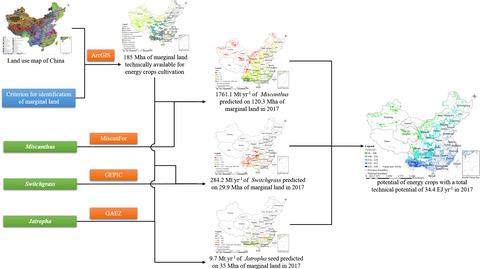当前位置:
X-MOL 学术
›
GCB Bioenergy
›
论文详情
Our official English website, www.x-mol.net, welcomes your
feedback! (Note: you will need to create a separate account there.)
Modeled spatial assessment of biomass productivity and technical potential of Miscanthus × giganteus, Panicum virgatum L., and Jatropha on marginal land in China
Global Change Biology Bioenergy ( IF 5.9 ) Pub Date : 2020-03-31 , DOI: 10.1111/gcbb.12673 Bingquan Zhang 1 , Astley Hastings 2 , John C. Clifton‐Brown 3 , Dong Jiang 4 , André P. C. Faaij 1
Global Change Biology Bioenergy ( IF 5.9 ) Pub Date : 2020-03-31 , DOI: 10.1111/gcbb.12673 Bingquan Zhang 1 , Astley Hastings 2 , John C. Clifton‐Brown 3 , Dong Jiang 4 , André P. C. Faaij 1
Affiliation

|
This article identifies marginal land technically available for the production of energy crops in China, compares three models of yield prediction for Miscanthus × giganteus, Panicum virgatum L. (switchgrass), and Jatropha, and estimates their spatially specific yields and technical potential for 2017. Geographic Information System (GIS) analysis of land use maps estimated that 185 Mha of marginal land was technically available for energy crops in China without using areas currently used for food production. Modeled yields were projected for Miscanthus × giganteus, a GIS‐based Environmental Policy Integrated Climate model for switchgrass and Global Agro‐Ecological Zone model for Jatropha. GIS analysis and MiscanFor estimated more than 120 Mha marginal land was technically available for Miscanthus with a total potential of 1,761 dry weight metric million tonne (DW Mt)/year. A total of 284 DW Mt/year of switchgrass could be obtained from 30 Mha marginal land, with an average yield of 9.5 DW t ha−1 year−1. More than 35 Mha marginal land was technically available for Jatropha, delivering 9.7 Mt/year of Jatropha seed. The total technical potential from available marginal land was calculated as 31.7 EJ/year for Miscanthus, 5.1 EJ/year for switchgrass, and 0.13 EJ/year for Jatropha. A total technical bioenergy potential of 34.4 EJ/year was calculated by identifying best suited crop for each 1 km2 grid cell based on the highest energy value among the three crops. The results indicate that the technical potential per hectare of Jatropha is unable to compete with that of the other two crops in each grid cell. This modeling study provides planners with spatial overviews that demonstrate the potential of these crops and where biomass production could be potentially distributed in China which needs field trials to test model assumptions and build experience necessary to translate into practicality.
更新日期:2020-03-31










































 京公网安备 11010802027423号
京公网安备 11010802027423号